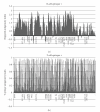Alzheimer's disease: a pathogenetic autoimmune disorder caused by herpes simplex in a gene-dependent manner
- PMID: 21234306
- PMCID: PMC3018626
- DOI: 10.4061/2010/140539
Alzheimer's disease: a pathogenetic autoimmune disorder caused by herpes simplex in a gene-dependent manner
Abstract
Herpes simplex is implicated in Alzheimer's disease and viral infection produces Alzheimer's disease like pathology in mice. The virus expresses proteins containing short contiguous amino acid stretches (5-9aa "vatches" = viralmatches) homologous to APOE4, clusterin, PICALM, and complement receptor 1, and to over 100 other gene products relevant to Alzheimer's disease, which are also homologous to proteins expressed by other pathogens implicated in Alzheimer's disease. Such homology, reiterated at the DNA level, suggests that gene association studies have been tracking infection, as well as identifying key genes, demonstrating a role for pathogens as causative agents. Vatches may interfere with the function of their human counterparts, acting as dummy ligands, decoy receptors, or via interactome interference. They are often immunogenic, and antibodies generated in response to infection may target their human counterparts, producing protein knockdown, or generating autoimmune responses that may kill the neurones in which the human homologue resides, a scenario supported by immune activation in Alzheimer's disease. These data may classify Alzheimer's disease as an autoimmune disorder created by pathogen mimicry of key Alzheimer's disease-related proteins. It may well be prevented by vaccination and regular pathogen detection and elimination, and perhaps stemmed by immunosuppression or antibody adsorption-related therapies.
Figures



Similar articles
-
Schizophrenia: a pathogenetic autoimmune disease caused by viruses and pathogens and dependent on genes.J Pathog. 2011;2011:128318. doi: 10.4061/2011/128318. Epub 2011 May 26. J Pathog. 2011. PMID: 22567321 Free PMC article.
-
Alzheimer's disease plaques and tangles: cemeteries of a pyrrhic victory of the immune defence network against herpes simplex infection at the expense of complement and inflammation-mediated neuronal destruction.Neurochem Int. 2011 Feb;58(3):301-20. doi: 10.1016/j.neuint.2010.12.003. Epub 2010 Dec 15. Neurochem Int. 2011. PMID: 21167244
-
APP, APOE, complement receptor 1, clusterin and PICALM and their involvement in the herpes simplex life cycle.Neurosci Lett. 2010 Oct 11;483(2):96-100. doi: 10.1016/j.neulet.2010.07.066. Epub 2010 Jul 30. Neurosci Lett. 2010. PMID: 20674675 Review.
-
Herpes Simplex Virus Type 1 and Other Pathogens are Key Causative Factors in Sporadic Alzheimer's Disease.J Alzheimers Dis. 2015;48(2):319-53. doi: 10.3233/JAD-142853. J Alzheimers Dis. 2015. PMID: 26401998 Free PMC article. Review.
-
Molecular Mechanisms for Herpes Simplex Virus Type 1 Pathogenesis in Alzheimer's Disease.Front Aging Neurosci. 2018 Mar 6;10:48. doi: 10.3389/fnagi.2018.00048. eCollection 2018. Front Aging Neurosci. 2018. PMID: 29559905 Free PMC article. Review.
Cited by
-
Schizophrenia: a pathogenetic autoimmune disease caused by viruses and pathogens and dependent on genes.J Pathog. 2011;2011:128318. doi: 10.4061/2011/128318. Epub 2011 May 26. J Pathog. 2011. PMID: 22567321 Free PMC article.
-
Amyloid beta (Aβ) peptide modulators and other current treatment strategies for Alzheimer's disease (AD).Expert Opin Emerg Drugs. 2012 Mar 23:10.1517/14728214.2012.672559. doi: 10.1517/14728214.2012.672559. Online ahead of print. Expert Opin Emerg Drugs. 2012. PMID: 22439907 Free PMC article.
-
The Role of PICALM in Alzheimer's Disease.Mol Neurobiol. 2015 Aug;52(1):399-413. doi: 10.1007/s12035-014-8878-3. Epub 2014 Sep 4. Mol Neurobiol. 2015. PMID: 25186232 Review.
-
Alzheimer's Disease: APP, Gamma Secretase, APOE, CLU, CR1, PICALM, ABCA7, BIN1, CD2AP, CD33, EPHA1, and MS4A2, and Their Relationships with Herpes Simplex, C. Pneumoniae, Other Suspect Pathogens, and the Immune System.Int J Alzheimers Dis. 2011;2011:501862. doi: 10.4061/2011/501862. Epub 2011 Dec 29. Int J Alzheimers Dis. 2011. PMID: 22254144 Free PMC article.
-
Can infections cause Alzheimer's disease?Epidemiol Rev. 2013;35(1):161-80. doi: 10.1093/epirev/mxs007. Epub 2013 Jan 24. Epidemiol Rev. 2013. PMID: 23349428 Free PMC article. Review.
References
-
- Itzhaki RF, Dobson CB, Lin W-R, Wozniak MA. Association of HSV1 and apolipoprotein E-ε4 in Alzheimer’s disease. Journal of NeuroVirology. 2001;7(6):570–571. - PubMed
-
- Itzhaki RF, Dobson CB, Wozniak MA, et al. Herpes simplex virus type 1 and Alzheimer’s disease. Annals of Neurology. 2004;55(2):299–301. - PubMed
-
- Itzhaki RF, Wozniak MA. Alzheimer’s disease-like changes in herpes simplex virus type 1 infected cells: the case for antiviral therapy. Rejuvenation Research. 2008;11(2):319–320. - PubMed
-
- Wozniak MA, Itzhaki RF, Shipley SJ, Dobson CB. Herpes simplex virus infection causes cellular β-amyloid accumulation and secretase upregulation. Neuroscience Letters. 2007;429(2-3):95–100. - PubMed
-
- Wozniak MA, Frost AL, Itzhaki RF. Alzheimer’s disease-specific tau phosphorylation is induced by herpes simplex virus type 1. Journal of Alzheimer’s Disease. 2009;16(2):341–350. - PubMed
LinkOut - more resources
Full Text Sources
Other Literature Sources

